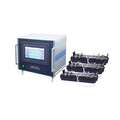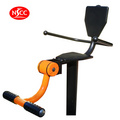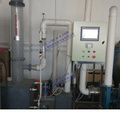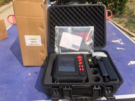Introduction to Audio Analysis and Audio Analyzer
Abstract: This article mainly introduces the basic knowledge of audio analysis and audio analyzer, from the basic concepts, audio analysis methods, audio analysis principles, audio parameter measurement and analysis, audio analysis instruments, etc., mainly introduces audio parameter measurement and The audio analysis method illustrates the basic indicators for measuring the quality of audio instruments. 1. Audio signal and audio analysis Audio is an important medium in multimedia. The frequency range of audio signals that we can hear is about 20Hz-2OkHz, where speech is distributed within 300Hz-4kHz, while music and other natural sounds are distributed in a full range. Sound is recorded or reproduced by analog equipment to become analog audio, and then digitized to digital audio. The audio analysis here refers to the process of taking digital audio signals as the analysis object and digital signal processing as the analysis means to extract a series of characteristics of the signal in the time domain and frequency domain. In the actual measurement, for convenience, the total signal voltage with noise is usually used instead of the signal voltage to calculate the signal-to-noise ratio. Step signal analysis is relatively simple and is mainly used to detect the response sensitivity of audio equipment to sudden signal changes. There are usually two parameters for step signal analysis, namely the rise time and pulse width of the step response signal. The smaller the rise time, the more sensitive the device's response to sudden signal changes and the better the transient characteristics; the smaller the pulse width, the better the damping characteristics of the device and the more stable the system. Sweep, welcome attention Official WeChat of Educational Equipment Procurement Network Master the latest and most authoritative information in the education equipment industry Copyright and Disclaimer: â‘ The copyright of all works on this website that indicate "Source: China Education Equipment Purchasing Network" belongs to China Education Equipment Purchasing Network, and may not be reproduced, edited or used in other ways without authorization from this website. Works that have been authorized by this website should be used within the scope of authorization, and indicate "Source: China Education Equipment Purchase Network". Violators of this website will be held accountable for legal liabilities. â‘¡ All works on this website that indicate "Source: XXX (non-this website)" are reproduced from other media. The purpose of this reprint is to transmit more information. This does not mean that this website agrees with its views and is responsible for its authenticity. Take direct responsibility and joint liability for infringement of such works. If other media, websites or individuals download and use it from this website, they must keep the "source of the manuscript" indicated on this website, and bear the legal responsibility of copyright and other. â‘¢ If the content of the work, copyright and other issues are involved, please contact this website within two weeks from the date of publication of the work, otherwise it is deemed to waive the relevant rights. The built-in camera of the 8 inch Attendance Face Recognition can take photos and archives of the card readers while swiping the card, so that the card readers have nowhere to hide. The speed of 8 inch temperature measurement Face Recognition is fast can detect the body temperature soon, and the card + photo is completed within 1 second. Adopt super large capacity memory in 8 inch facial identification device. Instant save. No personal privacy is involved. 8 Inch Attendance Face Recognition,8 Inch Temperature Measurement Face Recognition,8 Inch Facial Identification Device,8 Inch Face Recognition Guangdong Zecheng Intelligent Technology Co., Ltd , https://www.szzcsecurity.com
http: // 2007-8-3 Beijing Ocean Industrial Technology Co., Ltd.
Keywords: frequency response, harmonic distortion, signal-to-noise ratio, audio analyzer
Audio analysis of various specific frequency ranges has different application fields. For example, the analysis of speech signals between 300-4kHz is mainly used in speech recognition, its purpose is to determine the content of speech or to determine the identity of the speaker; and the analysis of the full range of speech signals between 20-20kHz can be used to Measure the performance of various audio equipment. The so-called audio equipment refers to the various types of electronic equipment used in the entire process of picking up the actual sound to play the sound, such as microphones, power amplifiers, speakers, etc. The main technical indicators of measuring audio equipment are frequency response characteristics, harmonics Distortion, signal-to-noise ratio, dynamic range, etc.
Second, the principle of audio analysis The principle of audio analysis mainly involves the basic theory of digital signal processing, the basic method of audio analysis and the measurement and analysis of audio parameters. Digital signal processing is the theoretical basis of audio analysis.
1. Basics of audio analysis technology Fourier transform and signal sampling are the most basic techniques used in audio analysis. The Fourier transform is the basis of spectrum analysis. The spectrum analysis of a signal refers to the frequency structure of the signal, the amplitude and phase of its components, and the frequency distribution rule to establish various "spectrums" with the frequency as the horizontal axis. Amplitude spectrum, phase spectrum. In the signal, the periodic signal undergoes the Fourier series transform to correspond to the discrete spectrum, and for the non-periodic signal, it can be regarded as the periodic signal with the period T as infinity. = 2Ï€ / T) approaches infinity, so that the discrete spectrum becomes a continuous spectrum. Therefore, the spectrum of aperiodic signals is continuous.
In a computer-centric test system, an analog signal passes through an A / D converter before it enters a digital computer, changing a continuous-time signal into a discrete-time signal, called signal sampling. Then the amplitude is quantized to become a discrete digital signal. In this way, a series of new problems will appear in the frequency domain, and the spectrum will change. After changing from analog signal to digital signal, its Fourier transform also becomes discrete Fourier transform, which involves a series of problems such as sampling theorem, frequency aliasing, truncation and leakage, windowing and window function.
2. Audio analysis method Generally, when an audio device is measured and analyzed, the device is regarded as a black box system with input and output ports. Input a certain known signal into the system, and then obtain the output signal from the output terminal for analysis to understand some characteristics of the system. This is the general method of audio analysis. The signal input to the audio device is called the excitation signal. The excitation signal may be a periodic signal such as a sine wave or a square wave, or a random signal such as white noise or pink noise, or a signal such as a double tone, multi-tone, or sine burst. The most commonly used detection and analysis methods include sinusoidal signal detection, pulse signal detection, and maximum length sequence signal detection.
3. Audio parameter measurement and analysis Audio measurement generally includes basic parameters such as signal voltage, frequency, signal-to-noise ratio, and harmonic distortion. Most audio parameters can be composed of these basic parameters. Audio analysis can be divided into time domain analysis, frequency domain analysis, time frequency analysis and other categories. Because the harmonic distortion of the signal is more important for audio measurement, it is separately classified as distortion analysis. The following introduces various audio parameter measurement and audio analysis.
1. Basic parameter measurement The basic parameters to be measured in audio measurement mainly include voltage, frequency and signal-to-noise ratio. Voltage testing can be divided into root mean square voltage (RMS), average voltage and peak voltage.
Frequency is one of the most basic parameters in audio measurement. Usually use high-frequency precision clock as a reference to measure the frequency of the signal. When measuring frequency, the input signal and the reference clock are counted at the same time within a limited time, and then the count value of the two is compared and multiplied by the frequency of the reference clock to obtain the signal frequency. As the computing speed of the microprocessing chip increases, the frequency of the signal can also be calculated by software using fast Fourier transform.
The signal-to-noise ratio is the basic performance index of audio equipment and the ratio of the effective voltage of the signal to the noise voltage. The calculation formula of the signal-to-noise ratio is:
2. Time domain analysis Time domain analysis is usually to input a certain test signal into the audio device to be tested, and observe the time domain waveform of the output signal of the device to evaluate the relevant performance of the device. The most commonly used time-domain analysis test signals are sinusoidal signals, square wave signals, step signals, and single-tone mutation signals. For example, inputting a sinusoidal signal into the device and observing the time domain waveform distortion of the output signal is a time domain analysis method.
Square wave analysis has good abruptness and periodicity. By observing the output signal waveform of the square wave signal of the device, the performance of the device can be well detected. Therefore, the square wave signal has become the most commonly used time-domain analysis signal. FIG. 1 is a detailed description of the response signal of the square wave of the audio device within half a period (rising edge). There are several main parameters to describe the square wave response, such as rise time, peak oscillation, overshoot and inclination.
Figure 1 Square wave response of audio equipment
The sinusoidal signal suddenly rises in peak value at a certain moment, forming a sudden change, which is a single-tone sudden change signal. Because the energy of the single-tone mutation signal is concentrated in a narrow frequency range, the single-tone mutation signal is commonly used to detect the response of the audio equipment at a specific frequency. The main purpose of the single-tone mutation signal is to quickly determine the damping characteristics of certain audio equipment, such as speakers.
3. Frequency domain analysis Frequency domain analysis is an important content of audio analysis. The main basis of frequency domain analysis is the frequency response characteristic curve. The aforementioned sinusoidal detection, pulse detection and maximum length sequence signal detection can all obtain the frequency response of the device. The frequency response curve reflects the distribution of the frequency response of the audio device in the entire audio range. Generally speaking, the frequency component at the peak of the curve has large sound pressure and strong sound pressure during playback; the frequency component at the bottom of the curve has low sound pressure and weak sound. If the peaks and troughs fluctuate too much, it will cause 



NES non-contact concrete shrinkage deformation tester 
HKG-1047 Knee Trainer 
Multi-channel gas synchronous controller 
Hydroxylamine hydrochloride-premium grade pure reagent price 
Dymola-Multidisciplinary system simulation platform 
Mobile socket 
Sponge foam tensile tear strength testing machine 
Data collection high efficiency wet dust collector ![Shuhua Brand Outdoor Fitness Path (Plastic Wood Series) SH-04014 four-position pedal [Please fill in the core parameters / selling points]](http://i.bosscdn.com/blog/20/20/04/2311164477520.jpg)
Shuhua brand outdoor fitness path (plastic wood series) SH -... 
Beijing vehicle weather system / integrated weather system / small ... 
Qingdao Xinxin Sports: Why does Star shine for a long time? 
Body Story Brand Story│Wilson's Three Logics in the Rise of Basketball 
China Railway Eighteenth Bureau ZT801 rock mass parameter measuring instrument put into use 
Huake Feiyang Announces "Sound and Body Beauty" Interactive Delivery Class 
Xiaoyu Yi Lianyun video conference helps 2 million teachers and students in more than 50,000 classrooms 
Yunnan "first class of school" Xiaoyu Yilian assisted more than 50,000 classrooms with 2 million teachers and students







